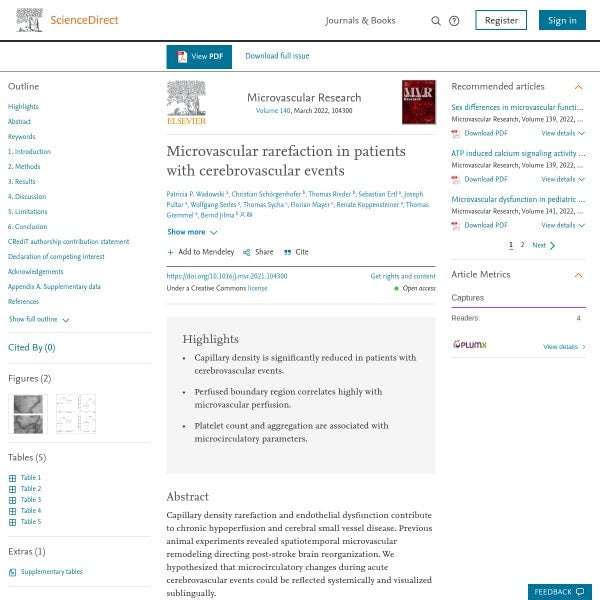
Microvascular rarefaction in patients with cerebrovascular events
Share
 ]
]Abstract
Capillary density rarefaction and endothelial dysfunction contribute to chronic hypoperfusion and cerebral small vessel disease. Previous animal experiments revealed spatiotemporal microvascular remodeling directing post-stroke brain reorganization. We hypothesized that microcirculatory changes during acute cerebrovascular events could be reflected systemically and visualized sublingually.
In a prospective observational trial in vivo sublingual sidestream darkfield videomicroscopy was performed in twenty-one patients with either acute stroke (n = 13 ischemic, n = 1 ischemic with hemorrhagic transformation and n = 2 hemorrhagic stroke) or transitory ischemic attacks (n = 5) within 24 h after hospital admission and compared to an age- and sex-matched control group. Repetitive measurements were performed on the third day and after one week.
Functional and perfused total capillary density was rarefied in the overall patient group (3060 vs 3717 μm/mm2, p = 0.001 and 5263 vs 6550 μm/mm2, p = 0.002, respectively) and in patients with ischemic strokes (2897 vs. 3717 μm/mm2, p < 0.001 and 5263 vs. 6550 μm/mm2, p = 0.006, respectively) when compared to healthy controls. The perfused boundary region (PBR), which was measured as an inverse indicator of glycocalyx thickness, was markedly related to red blood cell (RBC) filling percentage (regarded as an estimate of microvessel perfusion) in the overall patient group (r = −0.843, p < 0.001), in patients with ischemic strokes (r = −0.82, p = 0.001) as well as in healthy volunteers (r = −0.845, p < 0.001).
In addition, there were significant associations between platelet count or platelet aggregation values (as measured by whole blood impedance aggregometry) and microvascular parameters in the overall patient collective, as well as in patients with ischemic strokes.
In conclusion, cerebrovascular events are associated with altered systemic microvascular perfusion.
